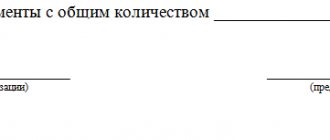Filing a tax return is an issue that concerns every individual entrepreneur. Even simple tax regimes (STS, UTII) require careful attention to the issue of filling out and submitting a declaration. We invite you to familiarize yourself in detail with the methods of drawing up, checking and sending declarations and choose the most suitable and convenient one.
Filing a tax return is an issue that concerns every individual entrepreneur. Even simple tax regimes (STS, UTII) require careful attention to the issue of filling out and submitting this document. We invite you to familiarize yourself in detail with the methods of drawing up, checking and sending declarations and choose the most suitable and convenient one.
How an individual entrepreneur can submit a tax return: types, deadlines, methods of submission
Every individual entrepreneur is, to one degree or another, concerned about the issue of timely submission of tax reports. In order for interaction with tax authorities to proceed smoothly, without errors, delays and claims from the Federal Tax Service, an entrepreneur needs to thoroughly understand these issues. The most important thing is to organize the process correctly: you can do some things yourself, but it makes more sense to outsource some functions to save time and money.
In this article we will tell entrepreneurs how to prepare and submit this type of tax reporting as a declaration.
An example of filling out an individual entrepreneur’s declaration on the simplified tax system in 2020
Let's look at how to fill out a report form for 2020 for an individual entrepreneur using the “income” system, at a tax rate of 6%, working without hiring employees. Let's assume that the trade tax is not paid, there were no targeted and charitable funds received.
In this case, you will need to prepare a title card, as well as sections 1.1 and 2.1.1.
First, fill out the title page and indicate the entrepreneur’s details.
Then, not the second page with section 1.1 is drawn up, but the next one - section 2.1.1, since the first section is filled out on its basis:
Here the individual entrepreneur puts attribute 2, since he works without employees (p. 102). Then, the income received during the year is reflected incrementally: for the first quarter, for 6, 9 months and for the year (pp. 110 - 113). Next, the simplified tax system rate is indicated - 6 percent (pp. 120 - 123), and the amount of tax is calculated for each period: income is multiplied by 6%, the calculated tax amount is determined (pp. 130 - 133). Lines 140 – 143 show the amount of insurance premiums by which the amount of tax payable is reduced. This calculation is made on the second page of the declaration, in section 1.1.
In this part, the amount of tax to be paid or reduced is determined quarterly, taking into account insurance contributions made.
As we can see, in our example, the entrepreneur does not pay income tax in the 1st quarter, since contributions to compulsory health and pension insurance exceeded the calculated tax amount. For six months, these payments are no longer enough to cover the amount of tax; accordingly, the individual entrepreneur must pay the state 4,189 rubles.
For 9 months, the tax will be calculated as follows: 32,997 rubles (assessed tax) – 29,374 (paid contributions) – 4,189 (calculated and transferred tax to the budget) = – 566 rubles. This figure means that for 9 months the businessman has overpaid and has the right to reduce the final amount of tax, which is reflected on line 080.
The total amount for the year subject to additional payment is determined as follows:
The amount of tax accrued for the year (line 133 of section 2.1.1) - paid insurance premiums for this period (line 143 of section 2.1.1) - payment for 1 quarter (line 040 of section 1.1) + reduction for 9 months (line 080 of section 1.1 ) = 55679 – 37470 – 4189 + 566 = 14586 rubles. Our entrepreneur is obliged to pay this amount to the budget by July 15, 2020, for 2020.
After filling out the declaration, the individual entrepreneur must carefully check the form and send it to the tax service.
What types of declarations should an individual entrepreneur submit and within what time frame?
It all depends on what taxation system the entrepreneur uses. For ease of perception, we will display this information in the form of a table:
| Applicable taxation system | Type of tax return | Due dates |
| Simplified taxation system (USN, simplified taxation system) | Declaration of the simplified tax system | Based on the results of the calendar year, but no later than April 30 of the following year |
| Unified tax on imputed income (UTII) | Declaration of UTII | Based on the results of each quarter, but no later than the 20th day of the first month of the next quarter |
| Patent taxation system (PSN, PSNO) | There is no need to submit a declaration. | |
| General taxation system (OSN, OSNO) | Declaration 3-NDFL | Based on the results of the calendar year, but no later than April 30 of the following year |
| Declaration 4-NDFL | No later than 5 days after the expiration of a month from the date of income | |
| VAT declaration | Based on the results of each quarter, but no later than the 25th day of the first month of the next quarter | |
| Unified (simplified) tax return (USTD) in the absence of transactions in the reporting period | At the end of the quarter no later than the 20th day of the month following the reporting period | |
| Unified Agricultural Tax (USAT) | Declaration of Unified Agricultural Tax | Based on the results of the calendar year, but no later than March 31 of the following year |
For late submission of tax reports, an individual entrepreneur may be assessed a fine: 5% of the unpaid tax amount for each month of delay, but not more than 30% of the underpaid tax and not less than 1000 rubles.
In what format to submit documents (on paper or via the Internet) depends on the type of taxpayer. Thus, the obligation to submit reports exclusively online is established for the following categories:
- everyone who is a VAT payer;
- taxpayers with an average number of employees of more than 100 people or newly created organizations employing more than 100 employees;
- the largest taxpayers, regardless of the number of employees.
Of course, an individual entrepreneur cannot be the largest taxpayer, and situations with 100 employees are also rare. Therefore, an entrepreneur can submit reports (except for VAT returns) on paper, visiting the Federal Tax Service, by mail or electronically.
What is an individual entrepreneur declaration
The declaration of an individual entrepreneur is considered an official document according to which a person reports to the tax service about income for a specific time. It provides financial control over the calculation and payment of taxes. The type of declaration and the specific number of documents depend on the form of taxation of the individual entrepreneur. According to the classical system, he must pay VAT, personal income tax and property tax, and as a result, submit three documents for consideration.
Why do you need an individual entrepreneur declaration?
To report on a specific tax, you need to create a tax return for individual entrepreneurs on a specific form, that is, papers of the same type are not submitted for review. However, all declarations have a title page with two sections. The title page contains figures with the final calculations of sections, insurance premiums and the amount of taxes. In the first section, the TIN with personal data, adjustment number, contact number, number and name of the tax authority, tax period codes and OKVED, signatures and date. The second section indicates the BCC with the OKTMO code, the actual address of the business activity, tax calculation and the type of work code.
Declaration title
How to prepare a declaration?
What can be used to prepare a document? The most “inconvenient” option is to fill out a printed form by hand. But this is impossible for a VAT return, and in other cases there is a high probability of error, and some parameters will have to be calculated “manually”.
It’s easier to use electronic programs: create a reporting file and save it in a “printable” format (if you plan to submit the document on paper) or in a “for sending” format (if you send it via the Internet).
Free programs
The first option: install the free “Taxpayer” program from the Federal Tax Service website. Doing this yourself is very difficult if you are not a professional programmer. In addition, you will have to monitor and install updates yourself. The advantage of the program is that it is free.
The second option: use professional online services that provide free promotional access to their services from time to time. Here is a brief overview of the most popular:
- "Circuit. Extern." The program allows you to fill out two main types of individual entrepreneur declarations: UTII and simplified tax system. A nice feature of the program is that you can connect to it for 3 months for free.
- Online accounting "My Business". In it, an entrepreneur will be able to fill out declarations under the UNDV, USN, OSNO taxation systems.
Employer reports
If an individual entrepreneur has employees, the set of reports and declarations becomes larger, because there is an obligation to report on personal income tax, contributions and the number of employees. This does not depend on the taxation system.
Within 30 days after concluding the first employment contract, the entrepreneur must register with the local branch of the Social Insurance Fund as an employer. There is no need to register with the Pension Fund - all data will be automatically transferred there by the tax office.
In the table we have collected all the reports that individual entrepreneurs must fill out and submit:
| Report title | What information does it contain? | Frequency and deadline for submission | Where to take it |
| 6-NDFL | About accrued and withheld personal income tax amounts for employees | Quarterly April 30 July 31 October 31 At the end of the year until March 1 starting in 2020 | Inspectorate of the Federal Tax Service |
| 2-NDFL | Employee income and personal income tax amounts withheld are submitted separately for each employee | Once a year until March 1 (starting from 2020) | Inspectorate of the Federal Tax Service |
| Calculation of insurance premiums | About accrued amounts for pension, medical and social insurance for employees | Quarterly April 30 July 30 October 30 January 30 | Inspectorate of the Federal Tax Service |
| Information on the average number of employees | About the number of employees over the past year | Once a year until January 20 | Inspectorate of the Federal Tax Service |
| Information on the average number of employees | About the number of employees over the past year | Once a year until January 20 | Inspectorate of the Federal Tax Service |
| SZV-M | Information about the insured persons | Monthly 15th | Pension Fund |
| SZV-experience and EDV-1 | Information about employee experience | Once a year before March 1 | Pension Fund |
| 4-FSS | About the amounts for insurance against industrial accidents and occupational diseases | Quarterly in paper (electronic) form: April 20 (25) July 20 (25) October 20 (25) January 20 (25) | FSS |
IP reports
The entrepreneur submits all these reports in full, even if he has only one employee.
In 2020, if an individual entrepreneur has 25 or more people on staff, these reports must be submitted strictly electronically ; paper reports will no longer be accepted.
From 2020, this threshold will decrease from 25 to 10 people, meaning even more employers will have to report exclusively electronically.
Professional services
In order not to waste time installing and updating software from the tax office website and not to depend on promotions of online services, you can install a professional accounting program that always has a tax reporting function.
The most famous and popular is, of course, 1C Accounting. But there are other programs for accounting and filing tax reports. Among the domestic ones, these are “Galaktika” and “Parus”, both have been on the market for more than 20 years. Among the foreign ones, SAP is the most famous.
But often an individual entrepreneur does not need the scope of functions that these programs offer. However, the cost of installation and maintenance can be quite onerous. Accounting programs are more affordable for large and medium-sized companies. There are more modern programs for accounting and tax reporting, aimed specifically at small businesses and individual entrepreneurs: Bukhsoft, My Business, Kontur.Extern and some others.
Therefore, it is worth taking a closer look at online services for filling out reports.
Here is a small table that will help you navigate your choice:
| Service name | Who is it aimed at? | Advantages | Prices |
| Bukhsoft Online | Individual entrepreneurs and small businesses | The ability to fill out all types of declarations required by individual entrepreneurs, simple connection, reporting testing and digital signature are included in the price. No need to install on your computer, it works online. | 2938 rubles per year. |
| My business | Individual entrepreneur on the simplified tax system and UTII | Specializes in the most popular tax regimes for individual entrepreneurs; EDS “in the cloud” is included in the tariff. | From 3990 per year. |
| Contour.Extern | Small businesses using the simplified tax system and UTII, medium-sized businesses (including in the field of alcoholic beverages) and budgetary enterprises located in St. Petersburg and the Leningrad region. | The ability to generate reports to all government agencies, including RPN and RAR, integration with 1C, the ability to correspond with the tax office, the ability to work from different computers, free access for a promotional period for 3 months. | From 2900 per year |
| Sky | Companies wishing to submit reports electronically. It is possible to draw up declarations of the simplified tax system, UTII, EUND, VAT. | The digital signature is issued in 1-2 days; there is no need to install or update it. There is a free tariff “Reporting only” | 100 – 170 rubles for one report when sending the report at the same time. |
How to calculate the simplified tax system
There are two types of simplified tax system, which differ in tax rate and tax calculation:
- STS "Income". The tax ranges from 1 to 6% of business income and is reduced by insurance premiums for individual entrepreneurs and employees. Read more about the reduction in the separate article “How to reduce the simplified tax system.”
- USN “Income minus expenses”. The tax ranges from 5 to 15% on the difference between income and expenses.
Each region can set its own rate. Find out your rate on the tax website.
Calculate the simplified tax system in Elba
Kontur.Elba will help you calculate tax and prepare a declaration under the simplified tax system!
Elba will calculate the tax on the simplified tax system “Income” and “Income minus expenses”. Get 30 free days when you sign up and try it yourself. If you are using the simplified tax system “Income” and all payments are sent to your current account, use our free service.
Tax holidays for new individual entrepreneurs
If you have registered a business in the social, industrial, scientific or public services sector, you may be subject to a tax holiday. Conditions for this:
- You have registered an individual entrepreneur for the first time.
- Tax holidays have been introduced in your region.
- You are running a business from the list of those that fall under tax holidays, and comply with other conditions from the regional law.
Find out whether you are covered by the holiday in our article “Tax holidays for individual entrepreneurs”.
In what ways can you test a declaration?
1. Online for free.
To do this, you will have to go through the registration procedure on the websites of services that provide services for generating and sending reports. “Kontur.Extern” deserves the most attention: it is this service that provides a complete interpretation of errors in reporting in simple “human” language. Here are some examples:
- Error: Element: FileDocument Error: '"" violates minLength constraint for '8'. Failed to parse 'OK' attribute.'
Hint: Check that the OKTMO code is filled in correctly. It must consist of 8 or 11 characters. You can also check the correctness of OKTMO on the Federal Tax Service website: https://www.nalog.ru/rn77/service/oktmo/ - Error: Element: FileDocumentNDFL6DokhNal Error: '"" violates the length constraint for "10". It was not possible to parse the attribute "TermPrchslNal" with the value "".'
Hint: “Tax payment deadline” (section 2) must be specified in the format DD.MM.YYYY. - Error: Field: Mismatch: Required attribute "RATE_MIS" is missing.
Hint: The field “Insurance rate according to professional risk class (%)” (Table 6, line 5) is not filled in.
2. In the CheckXML program provided by the Pension Fund.
To check in this way, you will first need to download this program from the Pension Fund website. This can be done for free, but there may be difficulties with installing the program.
Tax return of an individual entrepreneur
A tax return for individual entrepreneurs is a mandatory document that all entrepreneurs submit. Even those for whom the period turned out to be unprofitable.
If you do not provide the required paper on time, you can not only get bogged down in fines, but the tax inspectorate has the right to freeze the bank account and organize an administrative audit.
What is a tax return
The essence of the term “individual entrepreneur tax return” is disclosed in the Tax Code of Russia. In simple words, this is an official document through which an individual entrepreneur provides tax information about the amount of income for a certain period.
For each tax report, a special form is provided, that is, it is impossible to say that all businessmen submit the same type of document. But all types of declarations consist of approximately the same sections:
- Title page: final results of calculations from the second section, insurance premiums, tax amount.
- Section 1: INN, full name, correction number, telephone number, number and name of the tax authority, tax period codes and OKVED, signatures, date.
- Section 2: BCC, OKTMO code, actual address at which the activity is carried out, calculation of the duty and code of the type of activity.
Types of declarations
All individual entrepreneur declarations can be divided into basic, clarified, zero and final. The main one is submitted by all entrepreneurs. It contains information about all income received in the course of business activities. But other types should be issued only in special cases:
- Only individual taxpayers can submit the updated form. Those who need to make adjustments to the already submitted main document. It can be requested by the tax service if it finds inaccuracies or errors in the calculations, but the entrepreneur himself can submit it. The updated document is drawn up in the same way as the primary one, but on the front side of the form there will be a special stamp, and in the second section there will be a serial number of the correction.
- Zero is submitted by those businessmen whose activities were suspended during the reporting period. Not everyone can resort to this form of reporting and be exempt from paying tax - UTII payers calculate the amount payable not based on real income, but on the one imputed by the state, so a zero declaration is not provided for them.
- The final one is the one that is submitted before the closure of the individual entrepreneur . If you do not report to the Federal Tax Service, it will not accept the application for closure.
A more detailed classification of declarations depends on the types of taxes for which the businessman must report. And their list depends on the chosen taxation system.
IP on basis
OSNO is the most difficult mode. There are no concessions on it - only full reporting and payment of all possible tax deductions:
TaxRateTax base
| Personal income tax | 13% | All income for the tax period |
| VAT | 0—18% | Cost of goods/services on the day of sale |
| Property tax | 2,2% | Cadastral value of individual entrepreneur property |
The Russian government is striving to make accounting easier for entrepreneurs and is developing simplified regimes with less accounting red tape.
But many businessmen still work with OSNO, since large counterparties give preference to those who pay VAT.
This way they can reduce their tax payments.
Personal income tax reporting
Personal income tax payers submit 2 types of reports - on forms 3-NDFL and 4-NDFL. The latter is filled out once, as soon as the individual entrepreneur switches to OSNO and receives his first income for the year. It should indicate the amount of income received and the amount of expected annual income.
Using this information, tax authorities will calculate advance payments and send the payer a notification with the specified amounts and payment deadlines. After this, you cannot submit a 4-NDFL declaration. Even next year.
The income declaration of individual entrepreneurs on form 3-NDFL is submitted at the end of each reporting year. The deadline is April 30 . When this day falls on a weekend or holiday, the date shifts towards the nearest working day.
Report typeTimeframeFormat
| 3-NDFL | Previously April 30 | Paper |
| 4-NDFL | Within five days after receiving the first profit | Paper |
VAT reporting
To report VAT, form KND 1151001 must be submitted. Data is entered into it from the following documents:
- invoices;
- purchase/sale books;
- other accounting registers.
KND 1151001 is due by the 25th day of the month following the reporting quarter. When an individual entrepreneur does not work for the entire period and can confirm this by the absence of movements in accounts and cash registers, he has the right to submit a general simplified declaration instead of quarterly ones.
For property tax
The entrepreneur himself does not calculate property taxes. This is done by the tax office, after which it sends a notification to the taxpayer, which indicates the payment amount and payment deadline. Therefore, declaration for this type of duty is not carried out .
Reporting on UTII
UTII is calculated based on a certain ideal income that the state has assigned for a specific activity and region.
And this is a huge disadvantage of the regime, because you will still have to submit a tax return for individual entrepreneurs who did not function in the reporting period.
The duty must be paid, even if the enterprise’s profit is zero.
Not everyone can work under UTII, since the mode is not available in all regions; in Moscow, for example, it is not, and has clear restrictions:
- Less than 100 employees;
- Less than 25% share of participation of other organizations;
- Eligible activity.
In 2020, individual entrepreneurs must submit a new form for UTII - KND 1152016. The following fields have been changed in it:
- Removed line for KBK from the first section;
- OKUN codes are excluded from the second;
- In Appendix 3, paragraphs 4 and 5 have been updated;
- New barcodes;
- In the third section, a field was added for contributions for oneself under number 030; until 2020, individual entrepreneurs could reduce the tax only on fees paid in favor of employees, so only line 020 was provided in the form;
- New wording has appeared in fields 020, 030 of section number three.
The declaration of imputation is submitted quarterly. The deadline is the 20th day of the month following the reporting quarter.
QuarterDate (to)
| First quarter | 20 April |
| Second | July 20 |
| Third | The 20th of October |
| Fourth | January 20th |
If an individual entrepreneur has a small staff, up to 25 people, he has the right to submit a tax return in any of the existing ways: in person, through a representative, by mail, via the Internet. And if there are more than 25 people, only electronic submission is allowed.
https://www.youtube.com/watch?v=5Yj06Z2WQeA
When filling out a tax return, you should consider the following nuances:
- The K1 coefficient today is the same as in 2020 - 1.798;
- You can find out K2 (line 060) only from local authorities, many of them have changed;
- K2 is rounded to the nearest thousand;
- Other values are up to round amounts;
- If an individual entrepreneur reports on several types of work under different OKTMO, then additional lines 010, 020 should be filled in in the first section.
Reporting to the simplified tax system
The simplified tax system is the same general regime, only simplified to the limit. It can only be used by those entrepreneurs who have a staff of up to 100 people, income for a quarter of the year does not exceed 112 million rubles, and the type of activity is included in the list of permitted ones.
The simplified taxation system implies the payment of only one single tax, for which individual entrepreneurs submit the KND form 1152017. The rate and tax base depend on the selected object:
- Income . Only the company's income is taxed at a rate of 6%.
- Expenses . Individual entrepreneur income minus expenses is taxed at a rate of 15%.
The deadline for submitting a declaration for individual entrepreneurs using the simplified tax system is April 30 of the year following the reporting year. At the end of the quarters, advance payments are made, which the entrepreneur calculates independently.
The tax office does not check the legality of the advances made, leaving them on the conscience of the taxpayer.
But only before filing a tax return according to the simplified tax system, a reconciliation of the accrued and deposited amounts .
The simplified tax system has one undeniable advantage over UTII - in this mode, if the company has worked in the red, a zero tax return is filed. To do this, you need to fill out the same form, but a little differently:
- For individual entrepreneurs on the simplified tax system of 6%, the title page, section No. 1.1 and section No. 2.1.1 must be completed. If the payer pays a trade fee, you must also fill out section No. 1.1.2.
- For individual entrepreneurs on the simplified tax system of 15%, the data is entered on the title page, section No. 1.2 and section No. 2.2.
- When an individual entrepreneur submits a zero declaration, section 3 does not need to be filled out.
Filling procedure
The tax return must be completed in accordance with the requirements imposed by law for this type of document:
- Use capital letters and a pen with black ink.
- If you print, be sure to install the Courier New font.
- Don’t scribble, don’t resort to the help of a proofreader.
- Remember that each cell is a place for one sign or symbol.
- In empty cells you should put a dash , not a 0.
- Do not staple the report or print the text on both sides of A4.
- Start filling out the declaration from the last page, then proceed to section 1 and only then to the title page. This is more convenient, since the title page indicates the final information that was calculated in the previous ones.
- All values are rounded to whole numbers, for example, not 10 thousand 102 rubles, but 10 thousand 100 rubles. This rule is not relevant for K1 in the UTII declaration; this coefficient is rounded to the nearest thousandth.
When you start filling out the forms, keep all the necessary documents next to you. You should need:
- TIN;
- details of the Federal Tax Service;
- certificate of registration with the Federal Tax Service;
- statements confirming payment of taxes;
- code OKTMO, KBK, OKATO, OKVED.
Which authority should I submit to?
Entrepreneurs submit tax reports to their “native” tax office. That is, the one in which registration took place. Its location always coincides with the place of residence of the individual entrepreneur.
And a few more nuances:
- When sending a declaration by mail, one copy of the report is included in a registered letter. And as confirmation of acceptance of the declaration by the regulatory authority, you can use a shipping receipt, a notification with the seal of the Federal Tax Service and the signature of its employee.
- If a businessman combines several modes, the declaration must be submitted for each.
Delivery methods
The most understandable way to submit reports is to visit the tax office in person. But if you are in another country, do not rush to book a plane ticket, because individual entrepreneurs can submit a tax return remotely. Here are some options:
- Through a representative. In order for everything to go legally, you need to draw up and notarize a power of attorney for the authorized person.
- By mail. The envelope with the declaration must contain a list of the contents and a completed notification form, on which the employee of the Federal Tax Service who accepted the documents will put his signature and seal. In this case, you should prepare the declaration in advance, since the delivery of the letter will require additional time. You can receive a notification either by mail or at the authority itself.
- Through your personal account on the government services website. This method requires your own electronic signature and seal.
Deadlines for 2020 and 2020
Since, according to the law, the deadline for submitting reports, which coincided with a weekend, is postponed to the next weekday, the deadlines for filing a tax return for individual entrepreneurs in 2020 and 2020 may differ from the standard ones. Let's look at them in the table:
Type of declarationDeadline in 2020Deadline in 2019
| 3-NDFL | Until May 2 | Until April 30 |
| VAT declaration |
| Same dates |
| Declaration of UTII |
|
|
| Declaration of the simplified tax system | For 2020 to May 2, 2018 | For 2020 to April 30, 2019 |
IP violated deadlines: what will happen
For late submission of the declaration, the taxpayer will be fined.
Its amount depends on the type and importance of reporting, the length of the delay and the amount of tax that was payable.
However, payment of a fine does not exempt you from subsequently filing a return. Moreover, the sooner the debtor fulfills his obligations, the less he will have to pay.
A fine is not the most painful thing an entrepreneur can expect. Very often, tax authorities resort to seizing bank accounts .
They also have the right to write off the required amount to pay off the unpaid tax. And if an individual entrepreneur often fails to meet deadlines, this will become a reason to check all his activities.
The bottom line is simple: if you don’t want the tax office to have questions for you, submit the necessary papers on time.
Source: https://IP-vopros.ru/vedenie-ip/otchetnost/nalogovaya-deklaratsiya-o-dohodah
Sending in electronic format
The first thing you need to do is convert the file to the desired format. The Federal Tax Service accepts reports in xml format. If your reporting is generated in excel format, you need to tinker to convert the file to xml. You will have to understand the non-ordinary functions of Excel: https://lumpics.ru/how-to-convert-excel-to-xml/.
If the reporting is generated in pdf format, you can use an online file converter from pdf to excel. Then we save the excel file in xml format using the “save as” function.
But in order to avoid errors when saving a file in the required format, it is better to initially generate it in a program specially designed for this.
Next question: how to send a file over the Internet? There are the following ways to do this:
Responsibility for failure to submit or late submission of an individual entrepreneur’s declaration to the simplified tax system. Fines and sanctions
For failure to comply with reporting deadlines, the entrepreneur will be subject to sanctions.
The following types of penalties apply:
- The fine is 5% for each month of delay, calculated from the amount of tax payable specified in the declaration. At the same time, the minimum fine is 1000 rubles, and the largest penalty amount will be 30%. (Article 119 of the Tax Code of the Russian Federation)
- If an individual entrepreneur submits a “zero” declaration with a delay, a fine of 1,000 rubles is imposed.
- The Federal Tax Service has the right to block the current bank account of an individual entrepreneur if 10 days have passed since the deadline for reporting, and the businessman has not submitted a declaration.
- According to Article 15.5 of the Code of Administrative Offenses of the Russian Federation, company officials (manager - individual entrepreneur, chief accountant) face a warning or a fine of 300 to 500 rubles.
That is, if an entrepreneur has evaded submitting reports, the tax office issues an order requiring it to be submitted, and may also limit the rights to manage finances in a bank account. At the same time, penalties that you will have to pay accumulate. Therefore, a reasonable decision would be to avoid such negative consequences and submit the required form to the Federal Tax Service on time.
Free through the Federal Tax Service website
To do this you need to take the following steps:
- get an electronic digital signature key. This can be done in accredited centers listed on the website of the Ministry of Telecom and Mass Communications;
- obtain the subscriber ID using the appropriate section;
- install special software: “Taxpayer Legal Entity” and certificates;
- install crypto protection.
The programs offered by the Federal Tax Service sometimes work incorrectly and produce errors; moreover, not everyone knows how to install them correctly. You will also have to independently monitor software updates and download them from the tax service portal. This option can be called free quite conditionally: you will need to purchase an EDS key.
How to submit a tax return via the Internet: methods
Recently, an increasing number of services are provided via the Internet.
Particularly popular is sending documents, including tax returns, via the Internet to various government services.
What features does this procedure have? How to submit a tax return online? Can they refuse service?
The main pros and cons of remote filing of returns
The advantages of filing your taxes remotely far outweigh the disadvantages.
The main disadvantage is periodic failures and errors in accounting programs, as a result of which reports do not reach the Federal Tax Service on time.
However, such situations rarely arise when returns are filed within deadlines.
A full transition to electronic document management will not happen soon, since inspections require paper media.
The advantages of this method are:
- saving time (no need to visit the Federal Tax Service);
- ease of registration of the service (it is enough to register on the site once in order to receive the service in the future);
- a small number of errors when processing information in the Federal Tax Service (data is copied and not entered manually).
It is important to note that you can submit any type of tax return online.
What will you need?
To submit a declaration online, legal entities and individual entrepreneurs will need:
- extract from the Unified State Register of Legal Entities or Unified State Register of Individual Entrepreneurs;
- certificate from Rosstat with activity code;
- certificate of registration of an individual entrepreneur or legal entity with the tax service and state accounting;
- TIN;
- passport;
- other papers confirming the registration of a legal entity or entrepreneur.
How to submit a tax return via the Internet for an individual? To do this, you will need a passport, INN and SNILS.
What do you need to send documents over the Internet?
Before filing a tax return online, you will need to first conclude an agreement with the Federal Tax Service operator, who will subsequently send the documents electronically.
The cost of this service starts from 1.5 thousand rubles per year. In addition, you must have an electronic signature, which is needed to identify the applicant.
It is issued in one of the authorized services of the Ministry of Communications at the current place of registration (directly at the tax office or at the MFC).
How to submit a declaration via the Internet: methods
Individuals and legal entities can submit reports to the tax service via the Internet as follows:
- Through the Federal Tax Service website in your personal account.
- On the government services portal.
Federal Tax Service website
According to the current legislative norms of the Russian Federation, all legal entities must be registered on the website of the Federal Tax Service, that is, they must have a personal account where information required by the regulatory authority is stored. You can log into your personal account in the following ways:
- Using a pre-issued electronic digital signature.
- By entering the taxpayer's name and code from the registration card (issued at the tax office).
And individuals can register on the Federal Tax Service website. To do this, you need to enter your full name, INN and SNILS.
How to submit a tax return online on the tax office website? To do this, you will need to go to the section on working with declarations and reports.
The declaration is filled out according to the established form template. After filling out all fields of the document, it can be sent.
After a desk check of the document, a corresponding notification will appear in your personal account.
Public services portal
Filing declarations of any type can also be done through Gosuslugi.ru.
To use the service, you must register on this site and create a login and password.
Next, you need to download and install the software called “Taxpayer”. This software has a number of significant advantages, such as:
- the ability to create various documents electronically;
- automated filling of declarations;
- saving previously created and completed documents.
How to submit a tax return online using this program? After installing the software, applicants must regularly monitor for updates. The algorithm for filing a declaration is as follows:
- We select the required declaration form and enter all the information. The completed declaration can be saved on your computer.
- Individual entrepreneurs and legal entities indicate the code of the FNM branch where the declaration will be sent.
- We draw up an application and attach a reporting document to it. The taxpayer needs to save or write down its number.
- We send the report. After this, the applicant needs to track the status of processing the application in his account on Gosuslugi.ru.
- After receiving confirmation from the Federal Tax Service that the declaration has been received, its paper form can be certified with the seal of the organization (for legal entities and individual entrepreneurs) and the signature of an authorized person.
After this, applicants must first make an appointment with the Federal Tax Service. Before your visit, you should make sure that you have all the necessary seals and signatures.
In order to avoid problems with the tax office later regarding corrections and errors in the declaration, taxpayers are recommended to submit the document at least one day before the deadline.
Can they refuse to accept a document?
Filing a tax return online is quite easy, but will there be any problems with its acceptance? Refusal to accept reporting documents may occur in the following situations:
- lack of certification with an electronic digital signature;
- lack of information about the person responsible for filling out the declaration;
- presence of errors in the document;
- filing reports through non-certified services;
- impossibility of identifying a taxpayer using an electronic signature.
How to submit an income tax return online or any other reporting document to the tax office? This service is available on the Federal Tax Service website and the Gosuslugi.ru portal. Both legal entities and individuals can submit a declaration.
Source: https://.ru/article/282666/kak-podat-deklaratsiyu-v-nalogovuyu-cherez-internet-sposobyi
Sending by mail
To do this, you will need to print out the declaration on paper, sign it and put a stamp (if you have one), fill out two copies of the list of investments and write on the envelope (address of the Federal Tax Service and the address of the sender). Take the unsealed envelope with the declaration and two copies of the inventory to the post office. The branch employee will stamp and sign the second copy of the inventory and issue a payment receipt, which will indicate the shipment ID. Keep these documents in case the tax authorities claim that they did not receive your documents.
Where and how should individual entrepreneurs submit a declaration under the simplified tax system?
Business owners who use the simplified taxation system annually report their results to the tax office at the place of registration. In addition, the individual entrepreneur must keep a special book to reflect income and expenses. But this form is not required to be submitted unless specifically requested by the tax inspector.
The declaration must be submitted in accordance with the legally established form KND 1152017, approved by Order of the Federal Tax Service of Russia dated February 26, 2016 N ММВ-7-3/ [email protected]
There are several ways to send a report:
- Personal visit to the tax office.
In this case, two copies are drawn up: one is given to the inspector, and the second, with a mark of acceptance, is kept by the entrepreneur. You can also delegate the authority to submit a report to a representative. But for this you will need to issue a power of attorney for him, certified by a notary office.
- By mail.
In this case, it is safer to send the declaration by registered mail and make an inventory of the attachment. It is better to keep a copy of the inventory and the shipping receipt - they will be needed if you have to prove to the tax authorities that the declaration was submitted on time.
- Online communication channels.
To do this, programs installed at the workplace are used that communicate with services that accept reports. Through the operator providing such communication and using an electronic digital signature, the report is transmitted electronically to the tax office.
Attention! If an individual entrepreneur hires a staff of 100 or more people, reporting under the simplified tax system is possible exclusively in electronic form. With a smaller staff of hired employees, printing and submitting the declaration on paper is allowed.
If an individual entrepreneur works without an office, then from any computer connected to the Internet, you can send a report through the website of the Federal Tax Service. You can also use other specialized online services.
When do you need to submit a declaration using the simplified system?
Please note that due to the coronavirus pandemic, tax payment and reporting deadlines for some individual entrepreneurs and organizations may be postponed. Details are described in this article.
So, the majority of individual entrepreneurs who have switched to the simplified regime and continue to operate within its framework comply with the general reporting deadline. Let us remind you that the declaration under the simplified tax system for individual entrepreneurs for 2020 must be submitted before April 30, 2020 inclusive.
At the end of September 2020, Law No. 325-FZ adopted amendments to the Tax Code. Among other things, a change has been made to the concept of “first tax period” for those organizations and entrepreneurs who registered in December and chose the simplified tax system as their tax system (clause 4 of Article 55 of the Tax Code of the Russian Federation).
Before the aforementioned amendments came into force, the first tax period was considered to be from the date of registration in December until the end of the next year. For example, the company opened on December 15, 2020. The first tax period in this case is from December 15, 2018 to December 31, 2019. That is, companies and individual entrepreneurs using these special regimes had to submit their first declaration only in 2020.
But as of September 29, 2019, everything changed - the first tax period is now considered to be the period from the date of registration to the end of the same year. Those. organizations established in December 2020 must now report on general terms in 2020.
Filling out a document through the program
To draw up a reporting type declaration, you need to use specialized software. It is quite obvious that today there are a lot of commercial options for such programs; the Federal Tax Service website also has an interesting “Declaration” program, the use of which allows you to quickly draw up the required document. As data is entered into the program, it is updated, performs calculations, etc.
A program of this type must certainly be installed from official sources so that no complex aspects or nuances arise in the future. At the same time, it should be said that this program has a too narrow range of focus, since it allows you to draw up declarations of types 3 and 4 personal income tax. To learn how to use the program, you need to study all the features and nuances of entering personal data with it, and you also need to install it correctly. A specialized file is posted on the Federal Tax Service website, which provides instructions for installation. So, using the information provided, you can quickly draw up the document you need.
It should be said that this program has a lot of advantages that can make the process of drawing up reporting documentation simple and fast. The program corrects all errors at the filling out stage, which eliminates the formation of conditions when the declaration needs to be redone several times. This service also allows you to get the prospect of a quick calculation. But let’s say right away that the program was created to simplify the process of drawing up documentation for entrepreneurs; this program is not intended to send documents over the Internet.
There are also a lot of other programs that include all options for reporting documents, which allows entrepreneurs to get the prospect of quickly drawing up reports.











